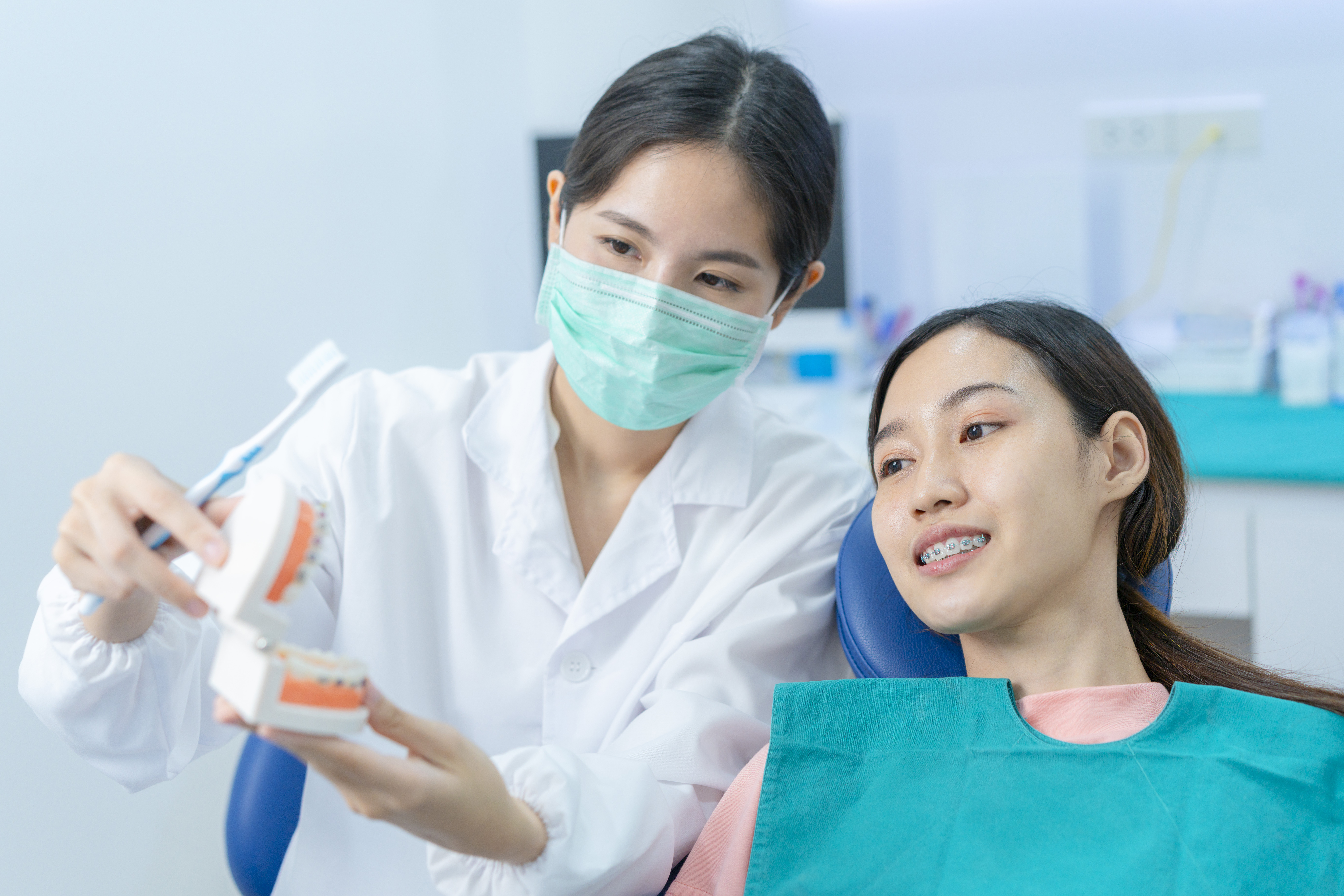
Treadmills everywhere have been dusted off, vegetables are being eaten instead of languishing in the back of the fridge, and refillable water bottles are, well, being refilled. Yup, New Year’s resolutions are in full swing! But did you know that being healthy goes beyond diet and exercise?
Of course, I’m talking about oral health. I am an El Dorado Hills orthodontist after all.
If you’ve been wondering, do straight teeth matter? Is an aligned bite really all that important? Are braces worth it? The answer is, yes!
There are some powerful health benefits of orthodontic treatment, including:
1. Improving Chewing and Digestion
When your teeth are strong and aligned, you’re able to eat and chew a wider variety of foods, including some of the most nutrient-dense ones like raw, crunchy vegetables. This ensures you get all of the necessary vitamins and minerals.
Another surprising health benefit of braces or Invisalign® treatment is healthier digestion. This is because the digestive process starts in the mouth and relies on fully chewing your food.
A 2001 study found that impaired chewing affected the oral bacterial flora and led to an increased risk of gastrointestinal problems. Another study conducted in 1992 also revealed a link between chewing problems and digestive issues, including bloating, cramps, and constipation or diarrhea.
2. Keeping Your Jawbone Strong
Do you have gaps between your teeth? Well, areas of the jawbone that aren’t stimulated by biting and chewing forces, like those gaps, get reabsorbed by the body.
Over time, this leads to jawbone atrophy and bone loss and puts you at risk for tooth loss. Since the jaw is part of your larger facial structure, this bone loss can negatively impact your sinuses, nerves, and muscles too.
Orthodontic treatment will create ideal alignment, so your teeth are filling out the dental arch, and we can set you up for success with your dentist to replace missing teeth. This preserves the bone for lifelong benefits to your oral health and appearance.
3. Controlling Harmful Oral Bacteria
Crooked teeth give plaque more places to hide. Plaque is the sticky bacterial film that clings to the teeth. It releases acids as it feeds on the sugars and starches you eat. These acid attacks erode your dental enamel, and when they happen often enough, tooth decay develops.
An excessive amount of plaque bacteria is also behind periodontal disease, or gum disease, which is a bacterial infection in the teeth-supporting tissues. If not treated, gum disease can spread to the jawbone, causing bone loss, as well as to other areas of the body.
Periodontal disease is tied to serious health conditions, including heart disease, Alzheimer’s disease, autoimmune diseases, premature birth, low birth weight, and more. While additional research needs to be done to establish if periodontal disease is the cause, the link alone is enough to underscore the connection between your oral health and overall health.
Straightening your teeth with orthodontic treatment makes removing plaque easier, so you’re less susceptible to cavities and gum disease.
4. Reducing Inflammation
Inflammation and systemic disease go hand in hand. Crooked teeth and/or a misaligned bite can contribute to inflammation in a few ways.
First, malocclusion may make you more likely to engage in teeth grinding and clenching (bruxism), though the jury is still out on the connection. Grinding can lead to damage of the teeth and it puts stress on the gums, jaw and temporomandibular joint (TMJ), leading to inflammation.
While orthodontics alone won’t stop teeth grinding, we can try to put the teeth in a position that will minimize the flattening and attrition of the teeth.
Also, as I noted above, crooked teeth are harder to keep clean, increasing the risk of further inflammation from tooth decay and gum disease.
5. Helping You Sleep Soundly
Improper tongue resting posture, mouth breathing, and lax facial muscles, which can all result from a small or narrow jaw, may lead to an obstructed airway and sleep-disordered breathing, including snoring, obstructive sleep apnea and upper airway resistance syndrome.
Obstructive sleep apnea and other nighttime breathing problems significantly impact the quality and quantity of your sleep. They’re tied to concentration difficulties, poor work and school performance, and health conditions in kids and adults.
There has been an increasing interest in what’s known as airway-focused orthodontics.Treatment involves maxillary expansion (widening the upper jaw) in addition to braces, InBrace®, or Invisalign to open the airway and prevent or alleviate sleep-disordered breathing.
The research on the topic isn’t quite there yet and, truthfully, maxillary expansion can’t guarantee that we can affect breathing in every case. That said, at Jeffrey Kwong Orthodontics, my team and I are airway aware. We can screen growing patients for issues and make the necessary referrals.
For adults, we do use surgical orthodontics (orthodontic treatment combined with corrective jaw surgery) to address sleep apnea when dental appliances and CPAP don’t work. This approach permanently moves the jaw forward, which then improves tongue position and the size of the airway.
6. Protecting Your Temporomandibular Joints (TMJ)
I’ve mentioned the TMJ a few times, which shows just how interconnected all of the systems of the body are. Malocclusion, as well as teeth grinding, puts stress on the TMJ.
That’s why, another of the benefits of Invisalign, InBrace, and braces is that treatment can keep the TMJ and related structures healthy. This is because I can create a treatment plan that brings the teeth, jaw, TMJ, chewing muscles, and facial structure into harmony, so they’re functioning at their best.
7. Promoting Nasal Breathing
The palate, or roof of the mouth, is the floor of the nose. A narrow palate means a narrow nasal airway. When you can’t breathe through your nose, you breathe through your mouth. Mouth breathing interferes with craniofacial development in kids and increases the risk of sleep-disordered breathing in both children and adults.
While more research is needed to definitively establish the link, there is evidence to suggest that when the width of the palate is behind an obstructed nasal airway, widening the palate with orthodontic treatment may make nasal breathing easier. This could also ward off frequent stuffy noses, sinus issues, and the consequences of mouth breathing.
8. Reducing and Alleviating Pain
Excessive enamel wear, bruxism, TMJ dysfunction, difficulty chewing, and many of the other complications of crooked teeth and a misaligned bite cause discomfort, including jaw pain, facial pain, neck pain, and earaches.
9. Boosting Your Confidence and Self-Esteem
We’ve established that there is an oral health-overall health connection. But there’s also a connection to mental health. Feeling self-conscious about the appearance of your smile or stressing over dental issues caused by crooked teeth impacts all areas of your life.
One of my favorite parts of being an orthodontist is witnessing my patients’ transformations, inside and out. As their new smile takes shape, their confidence and self-esteem soar. This improves their mental wellbeing and quality of life.
Ready to Experience the Health Benefits of Orthodontic Treatment?
If you’d like to improve your oral health, overall health, appearance, and confidence, let’s talk! Book a complimentary consultation at Jeffrey Kwong Orthodontics in El Dorado Hills, CA today. My team and I use advanced treatments and modern technology to help every patient achieve their healthiest smile.

